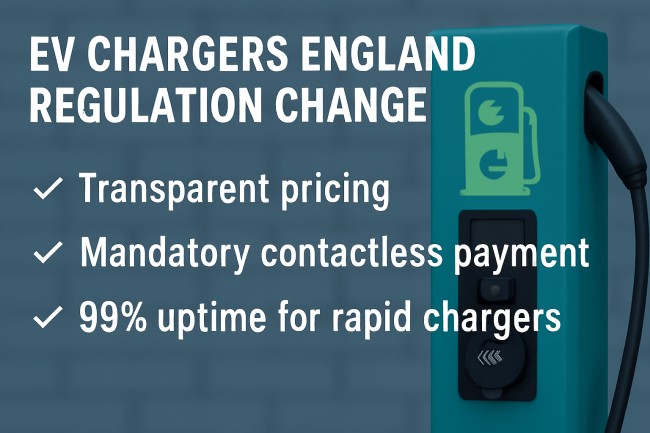EV Chargers England Regulation Change: A New Era of Charging Standards

As the world accelerates toward a greener future, EV chargers in England have become a critical component of sustainable infrastructure. To support this shift, the UK government has introduced significant regulatory changes to modernize and standardize electric vehicle (EV) charging. The “EV chargers England regulation change” marks a bold step toward user-friendly, accessible, and reliable public and private charging systems.
In this article, we will explore the details of these regulation changes, including what they mean for EV drivers, local councils, charge point operators, and property owners across England.
The Driving Force Behind the Regulation Change
Why the New EV Charging Regulations Were Needed
With over one million EVs now on UK roads, and the government’s plan to ban new petrol and diesel vehicles by 2035, the demand for fast, reliable, and easily accessible EV infrastructure has surged. However, previous regulations lacked consistency and user-friendly features. Complaints about poor reliability, lack of contactless payment options, and confusing pricing structures were common.
The EV chargers England regulation change was designed to eliminate these issues and build trust in the transition to electric transport.
Key Highlights of the New EV Charging Regulations
Transparent Pricing Mandate
One of the most crucial updates in the regulations is the requirement for clear and transparent pricing. Charge point operators must now display prices in pence per kilowatt-hour (kWh) before a user initiates a charge. This change ensures that consumers know exactly what they are paying—removing confusion and making it easier to compare options.
Mandatory Contactless Payment
To improve accessibility, all new public EV chargers above 8kW must support contactless debit or credit card payments. This rule also applies to existing rapid chargers (≥50kW), which must be upgraded by November 2024. This eliminates the need for downloading apps or using membership cards, making public charging faster and more convenient.
99% Uptime Requirement
Reliability is another focus of the new regulations. All rapid chargers (≥50kW) are now required to maintain 99% uptime, ensuring that drivers can rely on working infrastructure when they need it most. This is especially important for long-distance travel and emergency situations.
Roaming Compatibility
To promote network integration, operators must make their chargers accessible via at least one third-party roaming provider. This enables drivers to use different networks without needing multiple apps or accounts, creating a smoother and more consistent user experience.
Planning Law Reforms for EV Chargers
Permitted Development Rights Expanded
In May 2025, the UK government introduced updates to Permitted Development Rights (PDR), simplifying the installation of EV chargers. Homeowners and businesses can now install EV charge points without seeking local planning permission, provided certain criteria are met.
What This Means for Homeowners
If you have off-street parking (like a driveway or garage), you can now install an EV charger more quickly and affordably. This change removes the typical planning delay, saving time and often hundreds of pounds in application fees.
Benefits for Businesses and Public Spaces
Businesses and public institutions, such as schools or shopping centres, can now install chargers without bureaucratic hurdles. This will accelerate the deployment of workplace and destination charging, critical for supporting EV drivers throughout the day.
Supporting Households Without Driveways
Introduction of Pavement Gully Charging
To support the millions of people living in flats or terraced houses without driveways, the government has launched pavement gully charging schemes. These involve installing covered channels across pavements to allow EV owners to safely run a charging cable from their home to a vehicle parked on the street.
Local Authority Involvement
English councils are being encouraged to adopt these systems, supported by £25 million in government funding. Some pilot projects are already underway in urban areas, aiming to make home charging accessible to all, regardless of property type.
National Expansion Goals and Infrastructure Plans
Rapid Growth of Charging Infrastructure
As of mid-2025, the UK has surpassed 75,000 public charge points, a major milestone. The government aims to reach 300,000 by 2030, ensuring that every region—urban or rural—has adequate coverage. Charge points are now being added at a rate of more than one every 30 minutes.
Investment and Funding Initiatives
To achieve these goals, several national programs have been launched:
-
Local EV Infrastructure (LEVI) Fund: To support local councils in building infrastructure.
-
NHS Charging Expansion: Over 1,200 charge points are being installed at hospitals and clinics.
-
Motorway and A-road Signage Improvements: To help drivers easily locate nearby charging facilities.
These initiatives demonstrate a multi-tiered approach to improving EV charging access across the country.
Compliance and Accountability
How Operators Are Being Monitored
Charge point operators are now subject to stricter compliance requirements. The Office for Zero Emission Vehicles (OZEV) oversees implementation, ensuring that reliability, payment options, and accessibility standards are met. Operators who fail to comply may face penalties or removal from government-backed initiatives.
Role of Local Councils
While the central government provides funding and policy direction, local councils are responsible for on-the-ground implementation. Councils are expected to:
-
Upgrade existing infrastructure to meet standards
-
Support residents in implementing home charging solutions
-
Collaborate with private companies to expand networks
What This Means for EV Drivers
Easier, Fairer, and More Reliable Charging
For drivers, the EV chargers England regulation change means less frustration and more confidence. Whether you’re charging at home, at work, or on the go, you’ll benefit from:
-
Simple pricing
-
Quick, contactless payments
-
Reliable equipment
-
Wider access across networks
Increased Incentives to Switch to Electric
By removing barriers like unclear pricing and app-only payments, these changes also make it more appealing for petrol and diesel drivers to switch to electric vehicles. This is essential for meeting the UK’s net-zero emission goals by 2050.
Conclusion
The EV chargers England regulation change represents a significant leap forward in preparing the country for a fully electric transport future. These new rules prioritize user experience, infrastructure reliability, and fair access, ensuring the EV revolution benefits everyone—from city dwellers to rural drivers, from homeowners to council tenants.
As the UK continues to push toward greener mobility, these smart regulations will play a vital role in building an EV infrastructure that is future-proof, inclusive, and built to last.



